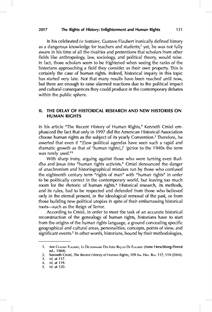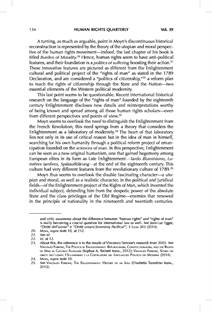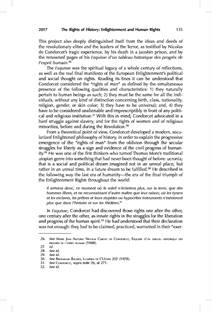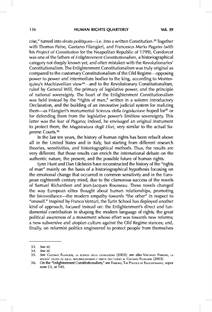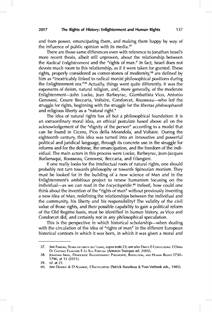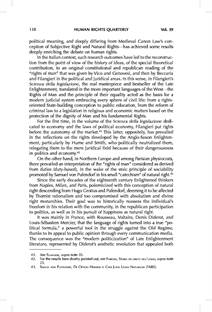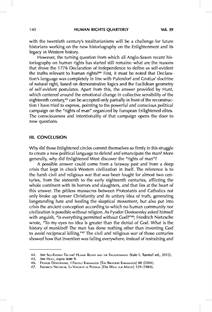Vol. 39
134
HUMAN RIGHTS QUARTERLY
A turning, as much as arguable, point in Moyn’s discontinuous historical
reconstruction is represented by the theory of the utopian and moral perspec-
tive of the human rights movement—indeed, the last chapter of his book is
20
titled Burden of Morality. Hence, human rights seem to have anti-political
21
features, and their foundation is a politics of suffering boosting their action.
These innovative features are pictured as different from the Enlightenment
cultural and political project of the “rights of man” as stated in the 1789
22
Declaration, and are considered a “politics of citizenship,” a reform plan
to reach the rights of citizenship through the State and the Nation—two
essential elements of the Western political modernity.
This last point seems to be questionable. Recent international historical
research on the language of the “rights of man” founded by the eighteenth
century Enlightenment discloses new details and reinterpretations worthy
of being known and spread among all those human rights scholars—even
23
from different perspectives and points of view.
Moyn seems to overlook the need to distinguish the Enlightenment from
the French Revolution; this need springs from a theory that considers the
24
Enlightenment as a laboratory of modernity. The heart of that laboratory
lies not only in its use of critical reason but in the idea of man in himself,
searching for his own humanity through a political reform project of eman-
cipation founded on the sciences of man. In this perspective, Enlightenment
can be seen as a new original humanism, one that gained hegemony among
European elites in its form as Late Enlightenment—Tardo Illuminismo, Lu-
mières tardives, Spätaufklärung—at the end of the eighteenth century. This
25
culture had very different features from the revolutionary culture of 1789.
Moyn thus seems to overlook the double fascinating character—a uto-
pian and moral, as well as a realistic character, in the political and juridical
fields—of the Enlightenment project of the Rights of Man, which invented the
individual subject, defending him from the despotic power of the absolute
State and the class privileges of the Old Regime—enemies that renewed
in the principle of nationality in the nineteenth and twentieth centuries.
and critic awareness about the difference between “human rights” and “rights of man”
is really becoming a crucial question for international law as well. See Jean-Luc Egger,
“Diritti dell’uomo” e “Diritti umani:Sinominia Pacifica?”, 3 leGes 503 (2014).
20. moyn, supra note 10, at 212.
21. See id.
22. Id. at 12.
23. About this, the reference is to the results of Vincenzo Ferrone’s research from 2003. See
vincenzo Ferrone, tHe Politcs oF enliGHtenment: rePublicanism, constitutionalism, anD tHe riGHts
oF man in Gaetano FilanGieri (Sophus A. Reinert trans., 2012); vincenzo Ferrone, storia Dei
Diritti Dell’uomo: l’illuminismo e la costruzione Del linGuaGGio Politico Dei moDerni (2014).
24. moyn, supra note 10.
25. See vincenzo Ferrone, tHe enliGHtenment: History oF an iDea (Elisabetta Tarantino trans.,
2015).
Dettagli
- Page N°:5
- Publication:
- Author:Vincenzo Ferrone



